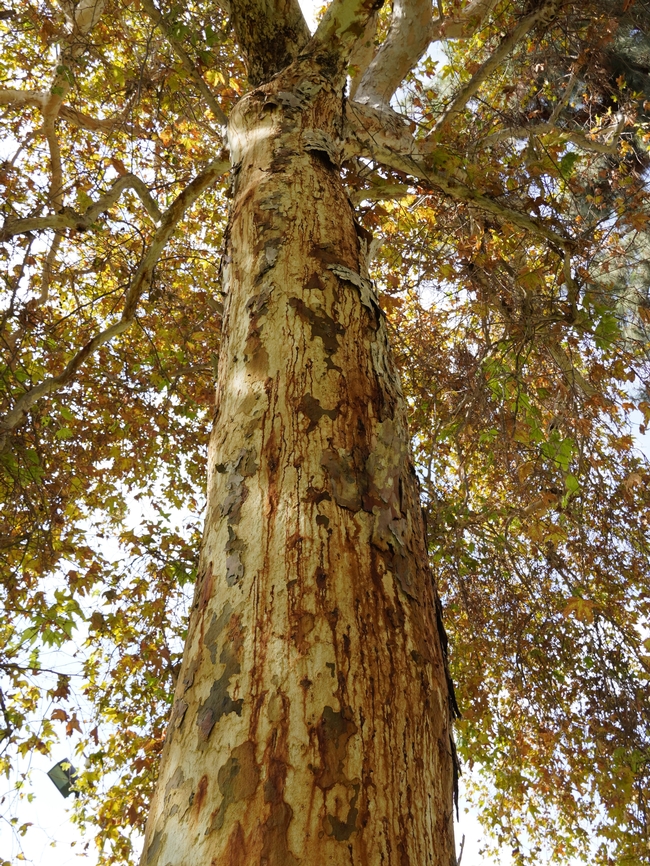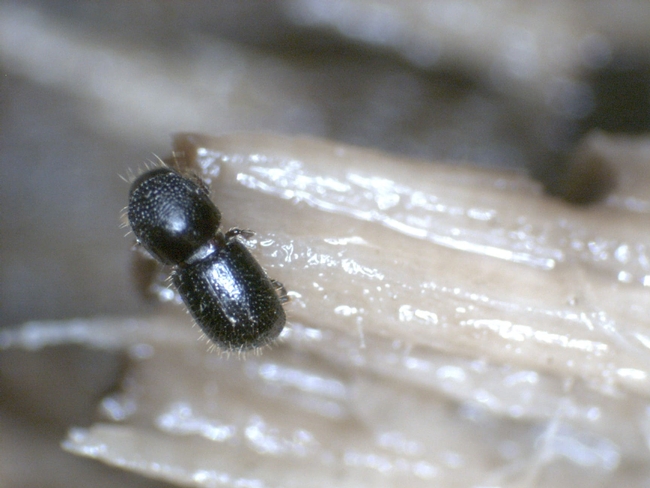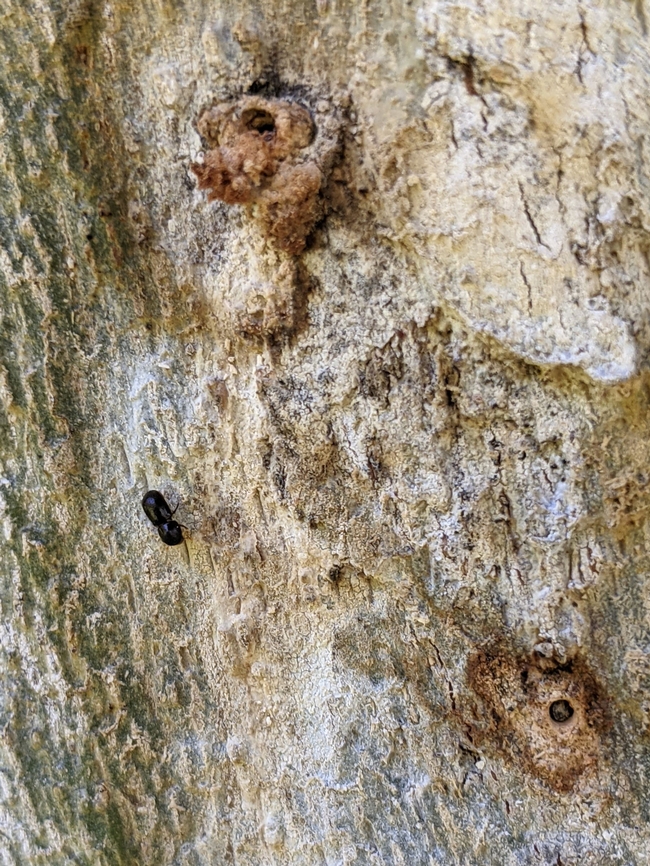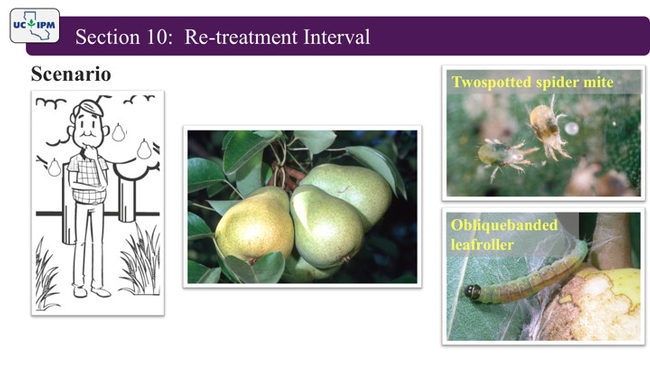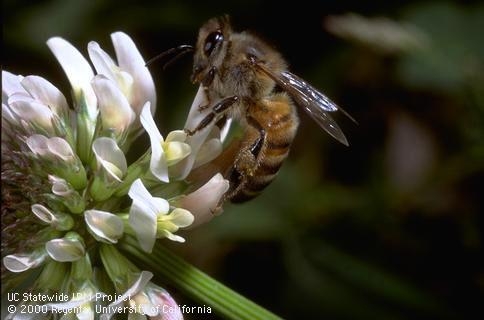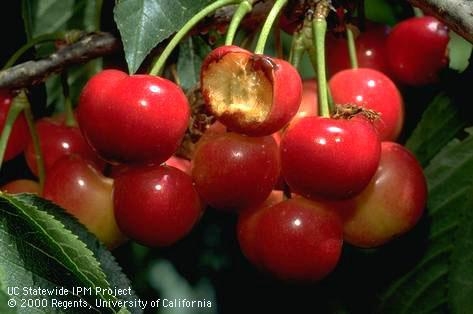Posts Tagged: UC IPM
After shothole borer invasion, UC Irvine becomes ‘perfect testing ground’
Results help inform best practices for managing the disease-causing beetle
The University of California, Irvine campus is home to a vast urban forest consisting of approximately 30,000 trees located in a mix of landscape, riparian and open space settings. In the mid-2010s, that forest came under threat from an invasive species of beetle that arborists and pest researchers were just learning about – the polyphagous shothole borer.
The tiny beetles, which may have arrived in California from their native Southeast Asia via infested shipping materials, tunnel into trees and introduce a fungus that serves as food for adult beetles and their larva.
As the fungus grows, it colonizes the tree's vascular system, blocking transport of water and nutrients. This causes a disease called Fusarium dieback that can kill branches or entire trees.
Shothole borers attack more than 100 species of trees and can live and reproduce in more than 65 tree species found in California. However, they seem to prefer box elders, sycamores and willows.
One reason the beetles were such a threat at UCI was the high number of sycamores on campus, especially in Aldrich Park at the campus center. Hundreds of cottonwoods, native willows, golden rain and coral trees also were affected. In total, the beetles attacked more than 2,000 trees, including 75 different tree species.
A variety of approaches to controlling beetle
To better understand and tackle this problem, UCI's Facilities Management department and Office of Environmental Planning and Sustainability collaborated with researchers affiliated with UC Agriculture and Natural Resources and UC Cooperative Extension. In addition, pesticide-manufacturing companies, pest control advisers and arborists provided materials and labor to help offset the cost of research.
“UCI was the perfect testing ground to determine integrated pest management strategies for this beetle/disease complex,” said John Kabashima, UCCE environmental horticulture advisor emeritus. “Our research was multifaceted, delving into early detection, monitoring and sampling, and cultural and chemical management.”
Kabashima said UCI provided the researchers with “a lot of freedom” to try a variety of approaches and study the results over time.
“We could cut down and sample trees or leave selected infested trees alone; we explored a variety of pesticide/fungicide combinations and application techniques,” he said. “That freedom resulted in many of the management solutions that are used today to effectively control this pest.”
UCI and the researchers also established a full inventory of affected trees on campus, evaluating severity of infestation by the number of entry/exit holes and signs of dieback. One important key to management is getting rid of “amplifiers” – heavily infested trees that are both hazardous and a source of beetles to spread to other trees.
“Typically, shothole borer infestations begin with just a few trees that for some reason are highly attractive to the beetles – perhaps based on tree species, tree spacing, irrigation conditions or other factors,” Kabashima said. “Over time, the beetles and fungus multiply largely undetected in those few trees. When the beetle population reaches a critical point and the trees begin to die, the female beetles fly to adjacent trees in a secondary invasion, eventually infesting many trees over a large area.”
An opportunity to diversify UCI's urban forest
At UCI, that initial invasion took place in landscaped areas containing many large, majestic sycamores that were planted when the campus began operations in the mid-1960s.
Over several years, UCI removed 700 heavily infested trees, including many of those historic sycamores, and replaced them with other tree species.
“We tip-toed into tree diversity, looking for other tree species that might be less susceptible to attack; we looked at 300 tree species that could be suitable for creating a more diverse tree forest as opposed to a street tree approach.” said Matthew Deines, senior planner with UCI Campus Physical & Environmental Planning. “We also planned for some redundancy in how we planted: If we had space, we would plant two trees of a single species and then plant backups with other species – what we did not want was a monoculture.”
Today, the forest at UCI is very different than it was in 2015. While shothole borers have not been eliminated completely, their presence is reduced significantly, and UCI now has the tools to manage them effectively. Reforestation efforts resulted in a diverse treescape that is not only more sustainable but also beautiful.
“Managing a 1,500-acre campus with 30,000 trees is a never-ending process,” said Richard Demerjian, UCI's assistant vice chancellor, Campus Physical & Environmental Planning. “Our forest continues to evolve, with an ongoing focus on increasing diversity and plant health.”
Demerjian also noted that UCI is now starting to consider planting new sycamore trees on a limited basis.
A primer on effective shothole borer management
Whether managing a forest of thousands of trees or just a few trees, landscape managers and residents can apply many of the lessons learned at UCI to control invasive shothole borers and other tree pests.
- Avoid monocultures. Tree diversity provides beauty and resiliency.
- Keep trees healthy. Proper irrigation and maintenance will keep trees strong and help protect them from shothole borers and other pests.
- Check trees. Look for the common signs and symptoms of infestation such as beetle entry/exit holes. Regular monitoring ensures that infestations are managed early, before they cause dieback or tree death.
- Confirm suspected infestations. Use the detection tool at www.ishb.org.
- Review management options. For trees with low infestation, prune the infested branches and monitor the tree's health over time. In non-riparian, urban settings, consider treating low and moderately infested trees with pesticides/fungicides demonstrated to be effective against the pest-disease complex (A licensed professional will be needed to apply the treatments). Severely infested trees may require removal.
- Call in a professional. A certified arborist or pest control professional would be able to provide recommendations based on the tree's condition. The local county Agricultural Commissioner's Office and UC Cooperative Extension office may have additional knowledge about current shothole borer monitoring and management programs in your area.
- Take care of green waste. The beetles can survive in cut wood for weeks or even months. Proper disposal of green waste includes chipping infested wood, followed by solarizing or composting the chips.
- Replant wisely. Begin planting new trees only after removing all amplifiers and establishing an ongoing monitoring program. Consider the current concentration of tree species when deciding what type of trees to plant.
New online course helps growers prevent illegal pesticide residues
Last month, a California grape farmer was fined $10,000 for using a pesticide in violation of the label, then packing and attempting to sell the tainted fruit. DPR detected the residues of a pesticide on the produced that was not registered for use on grapes.
Cases like this are rare in California but remind growers how important it is to apply pesticides correctly by following all pesticide label directions. The California Department of Pesticide Regulation (DPR) runs the most extensive Pesticide Residue Monitoring Program in the nation and is hard at work ensuring that the fruit and vegetables we purchase and consume are free from illegal pesticide residues.
Understanding and following label instructions is the focus of a new online course developed by the University of California Agriculture and Natural Resources Statewide Integrated Pest Management Program (UC IPM).
The program, Proper Pesticide Use to Avoid Illegal Residues, is targeted to those who apply pesticides or make pesticide recommendations. It explains what pesticide residues are, how they are monitored, and highlights important residue-related information from several sections of pesticide labels. In addition, the course identifies the following as the most important factors leading to illegal residues:
- Using a pesticide on a crop for which it is not registered
- Applying pesticides at an incorrect rate
- Ignoring preharvest intervals, re-treatment intervals, or plantback restrictions
Course participants are presented with several real-life scenarios. They must search through actual pesticide labels to determine if the scenario illustrates proper use of pesticides or if the described situation could potentially lead to illegal residues.
The overall goal of this course is to have participants follow pesticide label instructions when they return to the field. Following the label can eliminate incidences of illegal pesticide use.
Proper Pesticide Use to Avoid Illegal Residues is published just in time for pest control advisers and pesticide applicators who are still a few units short to renew their licenses or certificates with DPR. The course has been approved for two hours of Pesticide Laws and Regulations continuing education units (CEUs) from DPR and costs $40. If you don't need CEUs, but are still interested in viewing the course content, check it out for free on YouTube.
DPR recommends that renewal packets be submitted before Nov. 1 in order to receive your renewed license or certificate by Dec. 31, as the processing time can take up to 60 days. For additional online courses that UC IPM offers, visit the online training page.
Protect bees from pesticides by using bee precaution ratings from UC IPM
Our mission at the University of California Agricultural and Natural Resources (UC ANR), Statewide Integrated Pest Management Program (UC IPM) is to protect the environment by reducing risks caused by pest management practices. UC IPM developed Bee Precaution Pesticide Ratings to help pest managers make an informed decision about how to protect bees when choosing or applying pesticides. You can find and compare ratings for pesticide active ingredients including acaricides (miticides), bactericides, fungicides, herbicides and insecticides, and select the one that poses the least harm to bees.
Ratings fall into three categories. Red, or rated I, pesticides should not be applied or allowed to drift to plants that are flowering. Plants include the crop AND nearby weeds. Yellow, or rated II, pesticides should not be applied or allowed to drift to plants that are flowering, except when the application is made between sunset and midnight if allowed by the pesticide label and regulations. Finally, green, or rated III, pesticides have no bee precautions, except when required by the pesticide label or regulations. Pesticide users must follow the product directions for handling and use and take at least the minimum precautions required by the pesticide label and regulations.
A group of bee experts in California, Oregon and Washington worked with UC IPM to develop the Bee Precaution Pesticide Ratings. They reviewed studies published in scientific journals and summary reports from European and United States pesticide regulatory agencies. While the protection statements on the pesticide labels were taken into account when determining the ratings, it is important to stress that UC IPM's ratings are not the pollinator protection statements on the pesticide labels. In a number of cases, the ratings suggest a more protective action than the pesticide label.
The UC IPM ratings also include active ingredients that may not be registered in your state; please follow local regulations. In California, the suggested use of the Bee Precaution Pesticide Ratings is in conjunction with UC Pest Management Guidelines (for commercial agriculture) and Pest Notes (for gardeners). Each crop in the UC Pest Management Guidelines has a link to the Bee Precaution Pesticide Ratings database and provides guidance on how to reduce bee poisoning from pesticides.
For more information on protecting bees from pesticides, see UC IPM's Protecting Natural Enemies and Pollinators, and use the Bee Precaution Pesticide Ratings.
Experts converge in March to discuss human-wildlife conflict resolution
The Vertebrate Pest Conference is held every two years, usually in California, in cooperation with the Pesticide Applicators Professional Association (PAPA). The leading authorities with vertebrate management expertise from around the world congregate to present the latest research and extension information.
The conference is intended for animal control officials, wildlife managers, agricultural producers, pest control advisers, consultants, educators, researchers and natural resource managers. California Department of Pesticide Regulation and California Department of Public Health continuing education units are available for participants. Special symposia at the conference include bird, wild pig, and urban coyote management.
At the Vertebrate Pest Conference, experts will share the latest information about coyote attacks, human-coyote conflicts, and present several talks on coyote management, including hazing.
Niamh Quinn, a UC Cooperative Extension vertebrate pest advisor based at the UC South Coast Research and Extension Center in Orange County, is one speaker on the growing problem of urban coyotes. With over 3 million people in Orange County, 8 state parks and beaches, countless city parks and 19 county parks and wilderness areas, conflicts with urban coyotes are bound to happen. Managing coyotes includes managing people's behavior too.
“We can't manage what we can't measure. This conference provides a unique opportunity to discuss ongoing conflicts, especially those related to urban coyote management," Quinn said. "Research is needed to understand urban coyote behavior and if these behaviors are changing as a result of the way we are currently living. Outreach is needed to instruct urbanites on appropriate behavior where coyote conflicts are occurring, and managing coyotes is everyone's concern. We need better and improved strategies for measuring and managing these conflicts.”
Vertebrates are also problematic in commercial agriculture. A 2011 survey of wildlife damage by UC Cooperative Extension specialist on human-wildlife conflict resolution, Roger Baldwin, said agricultural losses from wildlife damage in California is likely in excess of $1 billion annually. Based on the survey results, economic losses were greatest for voles and pocket gophers in alfalfa; and wild pigs, birds, and ground squirrels in nut crops.
One talk at the Vertebrate Pest Conference will be a North American overview of bird damage in fruit crops. Other presentations cover field rodent repellents, food safety, and trapping.
UC IPM has information on vertebrate pest management for urban and communities, as well as commercial agriculture.
UC IPM providing helpful information on chlorpyrifos situation
Farmers gathered at the UC Kearney Agriculture Research and Extension Center in Parlier yesterday to discuss potential action by the EPA on the insecticide chlorpyifos, reported Ezra David Romero on Valley Public Radio. The meeting was hosted by UC Agriculture and Natural Resources (UC ANR) Statewide Integrated Pest Management project (UC IPM).
Chlorpyrifos is widely applied to many crops for pest control; the highest percentage on almonds, citrus, alfalfa and cotton. However, the U.S. Environmental Protection Agency has proposed cancellation of its use in agriculture.
"Chlorpyrifos is a tool and over reliance on that tool to help us solve pest problems is going to have environmental impacts and potentially could impact human populations as well," said UC ANR Cooperative Extension advisor David Doll in the Valley Public Radio story.
Romero also spoke to Selma almond grower Bill Chandler at the meeting.
"Don't give up the ship, there's help," Chandler said. "That's why they (UC IPM) had this meeting to say, listen gentlemen, there's these problems. Let's learn how to work with them and see what we can use differently."
More UC IPM meetings on the issue will be held in the coming weeks at the following locations:
Jan. 12 – Citrus in San Joaquin Valley
8 a.m. to 12:00 p.m.
UC ANR Cooperative Extension office, 4437 S. Laspina St., Tulare
Jan. 21 – Alfalfa in Imperial Valley
8 a.m. to 12:00 p.m.
Farm Credit Services Southwest, 485 Business Parkway, Imperial
Jan. 26 – Almonds in Southern San Joaquin Valley
8 a.m. to 2:30 p.m.
Kern County Agricultural Pavilion
3300 E. Belle Terrace, Bakersfield
Feb. 5 – Almonds in Northern California
8 a.m. to 12:00 p.m
Chico Masonic Lodge, 1110 W. East Ave., Chico
For more information contact Lori Berger, UC IPM chlorpyrifos project coordinator, at lberger@ucanr.edu or (559) 646-6523.

